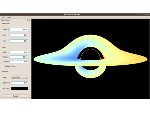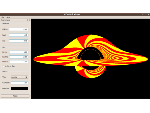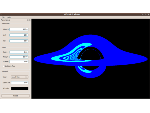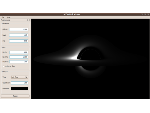Interactive visualization of a thin disc around a Schwarzschild black hole
In a first course in general relativity, the Schwarzschild spacetime is the most discussed analytic solution to Einstein's field equations. Unfortunately, there is rarely enough time to study the optical consequences of the bending of light for some advanced examples. In this paper, we present how the visual appearance of a thin disc around a Schwarzschild black hole can be determined interactively by means of an analytic solution to the geodesic equation processed on current high-performance graphical processing units. This approach can, in principle, be customized for any other thin disc in a spacetime with geodesics given in closed form. The interactive visualization discussed here can be used either in a first course in general relativity for demonstration purposes only or as a thesis for an enthusiastic student in an advanced course with some basic knowledge of OpenGL and a programming language.
The accompanying paper is published in the European Journal of Physics 33, 955-963 (2012).
A preprint version can be found at: arXiv:1206.4259v1 [gr-qc].
 |
 |
 |
 |
Application
The source code is available here:
linux archive | md5sum: 4f9daaa92a9f15253374d2e2c05bac7d
windows archive | md5sum: 4298a13ef323d55cff301d8494736df3
Plese note that you need Qt 4.7 or higher installed and a graphics board that supports OpenGL 2.0 and GLSL.
Installation:
1. Start qtCreator.
2. Open "thindisk.pro" project
3. Double-click on "thindisk.pro" file, adjust the line "TOP_DIR", and save the file.
4. Press 'Ctrl+5' brings you to the "Build Settings". Here, uncheck "Shadow build".
5. Press 'Ctrl+B' to build project.
6. Start the program with "Ctrl-R'.
Mouse handling:
· Left mouse button pressed -> change inclination.
· Right mouse button pressed -> change observer distance.
Android App
Simulate a thin accretion disk around a black hole on your Android device. The visualizations are based on Einstein's general theory of relativity for a Schwarzschild black hole. The apparent distortion of the disk is due to light rays that follow the curved spacetime.


